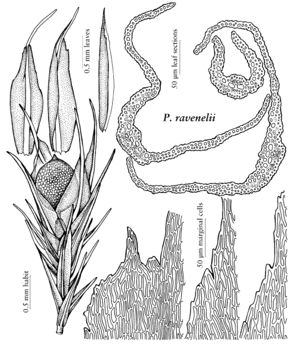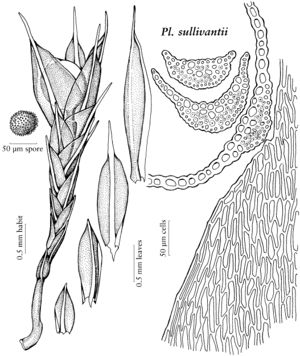| Taxon | Illustrator ⠉ | |
|---|---|---|
 | Pleuridium ravenelii | Patricia M. Eckel |
 | Pleuridium sullivantii | Patricia M. Eckel |
Plants gregarious to loosely tufted, yellow-green. Stems 0.3–0.7 cm, simple or branched; rhizoids at base, smooth. Leaves erect-spreading or appressed when dry, proximal leaves linear to deltoid, distal leaves oblong to lanceolate with subulate to acuminate tips, margins plane and undifferentiated, entire to serrate or abruptly toothed; costa subpercurrent to excurrent, sometimes roughened on the abaxial surface, stereid bands one or two, guide cells centrally located, confluent with the cells of the leaf lamina; basal laminal cells quadrate-rectangular, median cells irregular, rhomboidal to trapezoidal, marginal cells slightly longer than adjacent cells; distal cells elongated. Specialized asexual reproduction by innovations and rhizoidal tubers. Sexual condition monoicous; perigonia occur proximal to perichaetium with antheridia generally naked in leaf-axils (paroicous), or in small buds in axils of stem-leaves (autoicous); perichaetia single, terminal on mature stem, with 3–8 perichaetial leaves similar to the distal cauline leaves. Seta short, erect or curved. Capsule cleistocarpous, erect, immersed, orange to brownish, ovoid to elliptical; stomata 4–10, superficial, restricted to base of capsule. Calyptra mostly persistent, cucullate. Spores spherical, papillose to short-spinose.
Distribution
Worldwide except Antarctica
Discussion
Species 21 (4 in the flora).
Pleuridium is related to Ditrichum, as demonstrated by hybridization (L. E. Anderson 1980) and by similarities in gametophyte morphology and molecular characters (C. La Farge et al. 2000). Pleuridium is also closely related to Cleistocarpidium by the immersed cleistocarpous capsules but C. palustre has mitrate calyptras and pale whitish capsules, which are asymmetrical and stomatose to the equator. In Pleuridium, sporophytes may emerge laterally from the perichaetium, not because of an actual lateral origin or position, but owing to the curvature of a short seta (H. A. Crum and L. E. Anderson 1981), or because an innovation originated proximally and developed beyond the perichaetium (Chen P. C. et al. 1963), in some species of Archidium originally included in the genus (J. A. Snider and W. D. Margadant 1973). Rhizoidal tubers were reported for the genus by T. Arts and S. Risse (1988). The “central accessory cells” as used here are equivalent to Begleiter or hydroid cells of other authors.
Selected References
Lower Taxa
Key
| 1 | Fertile plants capitate, julaceous proximal to abruptly enlarged and spreading perichaetial leaves; sterile plants julaceous throughout, bearing short, appressed, blunt leaves; cells at shoulder of perichaetial leaves rhombic; costa in transverse section showing a single extensive abaxial stereid band and adaxial guide cells. | Pleuridium sullivantii |
| 1 | Fertile plants erect-patent proximal to gradually differentiated perichaetial leaves; sterile plants with leaves erect-patent, erect to flexuose-spreading; cells at shoulder of perichaetial leaves linear; costa in transverse section with a wider abaxial stereid band, a narrow adaxial stereid band, and central guide cells | > 2 |
| 2 | Perichaetial leaf lamina in transverse section uniformly 1-stratose at shoulder; plants autoicous, antheridia enclosed in leafy buds in axils of stem leaves. | Pleuridium subulatum |
| 2 | Perichaetial leaf lamina in transverse section at least partly 2-stratose at shoulder; plants paroicous, antheridia in axils of stem leaves naked or subtended by a membranous bract | > 3 |
| 3 | Shoulders of perichaetial leaves with jagged teeth; leaf lamina in transverse section 2-stratose on either side of costa, 1-stratose towards margin, plicate at the transitional area. | Pleuridium ravenelii |
| 3 | Shoulders of perichaetial leaves uniformly serrulate but never jagged; leaf lamina in transverse section sporadically to completely 2-stratose leaving the margin narrow and 1-stratose, concave, plicae absent. | Pleuridium acuminatum |